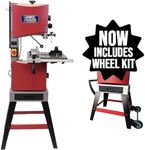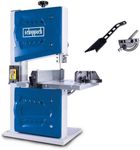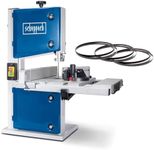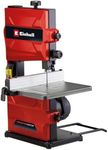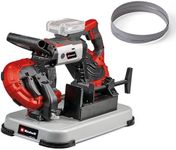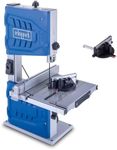Buying Guide for the Best Benchtop Bandsaws
Choosing the right benchtop bandsaw can greatly enhance your woodworking or metalworking projects. A benchtop bandsaw is a versatile tool that allows you to make precise cuts, curves, and intricate designs with ease. When selecting a bandsaw, consider the types of materials you'll be working with, the space available in your workshop, and the level of precision you require. Understanding the key specifications will help you make an informed decision that suits your needs and enhances your craftsmanship.Blade SizeBlade size refers to the length and width of the bandsaw blade. This is important because it determines the depth and type of cuts you can make. Blades come in various sizes, typically ranging from narrow blades for intricate curves to wider blades for straight cuts. If you plan to work on detailed projects, a narrower blade might be suitable, whereas wider blades are better for cutting thicker materials. Consider the types of projects you will be undertaking to choose the right blade size for your needs.
Cutting CapacityCutting capacity is the maximum thickness and width of material that the bandsaw can handle. This is crucial for ensuring that the saw can accommodate the size of the workpieces you plan to cut. Cutting capacity is usually divided into two segments: the throat capacity, which is the distance between the blade and the frame, and the resaw capacity, which is the maximum height of the material that can be cut. If you frequently work with large or thick materials, opt for a bandsaw with a higher cutting capacity to ensure versatility in your projects.
Motor PowerMotor power is measured in horsepower (HP) and indicates the strength and efficiency of the bandsaw. A more powerful motor can handle tougher materials and provide smoother cuts. Bandsaws typically range from 0.5 HP to 1.5 HP for benchtop models. If you plan to cut dense hardwoods or metals, a higher horsepower motor will be beneficial. For lighter materials or occasional use, a lower horsepower motor may suffice. Consider the types of materials you will be cutting to determine the appropriate motor power for your bandsaw.
Table SizeTable size refers to the dimensions of the surface where you place your material for cutting. A larger table provides more support and stability, especially when working with larger pieces. Tables can vary in size, with some offering extensions for additional support. If you often work with large or unwieldy materials, a larger table will be advantageous. For smaller projects or limited workspace, a compact table may be more suitable. Assess the size of your typical workpieces and your workspace to choose the right table size.
Speed SettingsSpeed settings refer to the adjustable speed of the bandsaw blade, usually measured in feet per minute (FPM). Different materials require different cutting speeds for optimal results. Bandsaws with variable speed settings allow you to adjust the speed to match the material being cut, providing better control and precision. If you work with a variety of materials, a bandsaw with multiple speed settings will be beneficial. For specific materials or consistent projects, a single speed may be sufficient. Consider the range of materials you plan to cut to determine the necessary speed settings.
